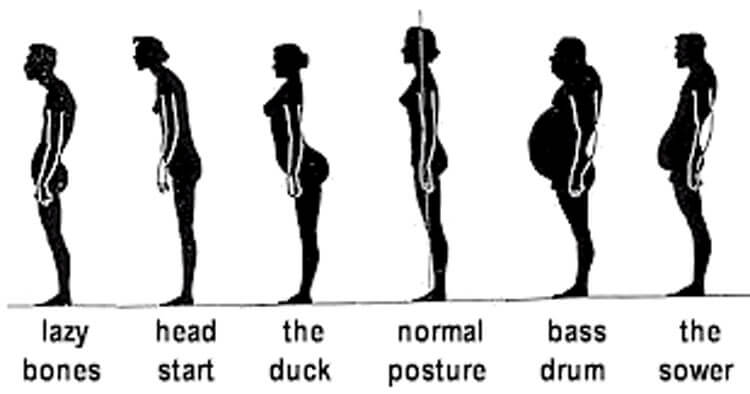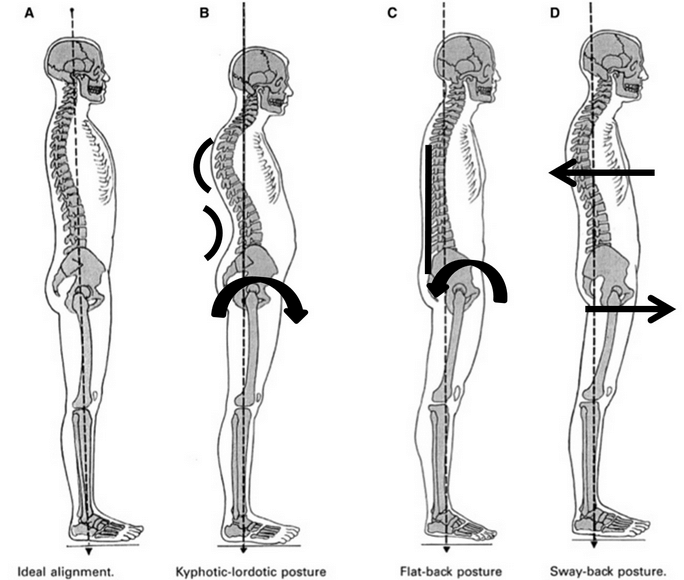Back and Joint Pain
Sway Back Posture: A Common Postural Variation
What Is Sway Back Posture?
Sway back posture is a very common postural variation. With “ideal” posture in standing being such that if you draw an imaginary line from your head all the way to the ground, your ear, shoulders, pelvis and ankles should all be stacked up within the same line. With a sway back posture (as per highlighted in the image shown below) the pelvis is pushed in front of the centre of gravity (being forward of the line), this shift causes a chain reaction as the body attempts to compensate elsewhere for the adjustment in alignment.
When viewing a sway back posture from side on as in the image, you can clearly see the pelvis and hips move forward of the line and the compensatory movement of the shoulders falling behind the line. Prolonged standing and walking with this postural variation may eventually lead to the individual experiencing discomfort, especially so if the individuals life requirements hobbies, sports, occupation, are such that it necessitates they stand for extended periods in the day.
Common Signs And Symptoms
The movement away from ideal posture with a sway back postural variation will tend to have many, or all of the following visual signs:
- The individual may well appear to have hyper extension of their knees. The habit of locking your knees backwards and “hanging” on your hips is very common with a sway back.
- With the hips and pelvis shifted forward the individual may have the appearance in standing of having “flat” buttocks where the usually round shape associated with the buttocks is reduced.
- As the chest and shoulders counter the forward hips and shift backwards behind the line it can give the individual the appearance of having a somewhat “sunken” chest.
- A Slumping, slouched shoulder appearance.
- A head poking forward. The appearance that the chin is poking forward of the mid line is again another adjustment the body makes in relation to the hips moving forwards. As the hips move forwards, the shoulders and chest backwards and ultimately then the head pokes forwards all in an attempt to help maintain the individuals centre of gravity keeping them upright and balanced.
Common signs on assessment of someone with a sway back posture will frequently reveal the following:
- The individual will likely have tight hamstring muscles
- A posteriorly rotated, or neutral pelvis (not likely to have an anterior pelvic tilt)
- Poor core muscle activation, they are usually “hanging” on the front of the hips in standing using this to support themselves and therefore reducing necessity for core and gluteal activation.
- Will present with a long rounded middle back, with early flexion in the upper lumbar levels that would usually be lordotic not kyphotic.
- Shoulder blades are often protracted around the chest wall, rounding out further away from the spine than normal.
Tip: If you suspect you may have a sway back they try to avoid sleeping on your stomach and invest in getting a new, firm mattress. Also request to have your workstation ergonomically assessed, this will assist in encouraging you to maintain correct alignment when working. A physiotherapist will be able to assist in giving you some key things to think about and work on to improve your posture and work to correct a sway back.
Disclaimer: Sydney Physio Clinic provides this information as an educational service and is not intended to serve as medical advice. Anyone seeking specific advice or assistance on Sway Back Posture: A Common Postural Variation should consult his or her physiotherapist, general practitioner or otherwise appropriately skilled practitioner.



